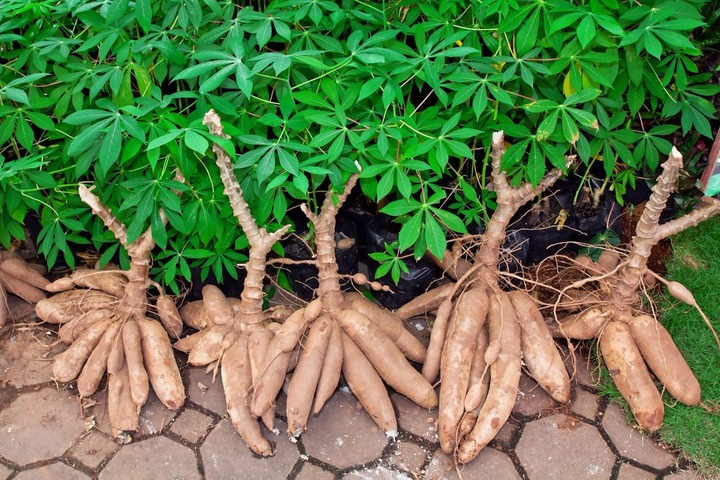You might be wondering what cassava is before you think to ask what it might be good for, but in light of its amazing properties, this rather sweet, starchy and nut-flavored tuber may become a staple in your pantry.
Cassava (Manihot esculenta), also known as manioc or yuca (not yucca), belongs to the spurge family of plants called Euphorbiaceae. It most likely originated in South American forest regions, but it’s also grown very inexpensively in parts of Asia, Africa and the Southern U.S. For centuries, it’s been a food mainstay for millions.
Hong Kong’s Centre for Food Safety says cassava contains more than one form of cyanogenic glycosides — sweet and bitter:
“Different varieties of cassava are generally classified into two main types: sweet cassava and bitter cassava. Sweet cassava roots contain less than 50 mg per kilogram hydrogen cyanide on fresh weight basis, whereas that of the bitter variety may contain up to 400 mg per kilogram.”1
Cassava is a perennial, usually grown in tropical climates, very simply propagated by using a cut portion of the stem. The roots, often compared to large yams, can weigh several pounds. They have tough, scaly and brown skin and starchy, white “meat” inside, but care must be taken in harvest because the shelf life is only a few days.
Purchase cassava roots (or flour) at large groceries, and store them at room temperature for a week. They can then be peeled and boiled, baked or fried, cooked and dried for later use, or fermented.
The leaves are also used for food and contain 100 times more protein than the root, but both must be cooked and the water discarded.2
The Odd and Advantageous Benefits of Cassava
While cassava roots are close to what we know as white potatoes, cassava contains almost twice the calories, and may be the highest-calorie tuber known. One cup of boiled cassava contains 330 calories, 78 grams of carbohydrates, 3 grams of protein and 4 grams each of fiber and sugar.3
Being naturally gluten-free, cassava is extremely useful for celiac patients and others trying to avoid gluten. One aspect of cassava is that it’s one of several root foods defined by the Philippines’ Department of Science and Technology as having a low glycemic index(GI) and therefore good for diabetics.
“GI is a classification of food based on the blood glucose response to a food relative to a standard glucose solution. Low glycemic foods control the release of glucose into the bloodstream at a steady and sustained rate, keeping the body’s metabolic processes and energy levels balanced.
People with low glycemic diets or [who] eat low glycemic foods are said to have lower risk of getting coronary heart disease and type 2 diabetes.
These food items that have low GI would benefit those who are already suffering from diabetes, since these would help in the proper control and management of blood sugar.”4
As a low-GI food, eating cassava can also help improve physical endurance because blood glucose levels are moderated instead of dropping when insulin is produced.
Low-GI foods also may help control triglyceride and other lipid levels in your blood. Cassava has even been called a “weight loss wonder food” due to its ability to decrease appetite and decrease fat storage in fat cells.5
B-complex vitamins contained in cassava include folate, thiamin, pyridoxine (vitamin B6), pantothenic acid (vitamin B5) and riboflavin (vitamin B2). The root also includes a number of minerals that perform important functions throughout your body:
| Iron helps form the two proteins responsible for transporting oxygen to your tissues | Zinc helps your immune system fight bacteria and aids cell growth and division | Calcium helps form strong bones and teeth |
| Magnesium optimizes mitochondrial function and helps regulate blood sugar | Potassium synthesizes proteins and helps break down carbohydrates | Manganese is vital for connective tissue and sex hormones, and repairing joints |
Cassava also contains saponins that can ease inflammation, break down organic body wastes like uric acid, cleanse mineral deposits from your joints and help balance your gut flora.
Tapioca: Starch From the Cassava Root
If you’ve ever had tapioca, you’ve had a form of cassava, as tapioca is the starchy liquid extracted from the root; cassava is the ground root itself. The content is essentially pure carbohydrates, with negligible fiber, protein or nutrients. In fact, one study called tapioca “nutritionally inferior.”6
One cup of dry pearl tapioca contains 544 calories, 135 grams of carbohydrates and 5 grams of sugar. There are virtually no vitamins to speak of, other than a small amount of folate and pantothenic acid, but the same amount yields 13 percent of the recommended daily value in iron and 8 percent of the manganese.7
Moisture is removed from the root either by evaporation or squeezing it out after being ground, leaving a fine, white powder. Dried, it’s often sold as flour or pressed into flakes or “pearls,” which should be boiled before you eat them; 1 part dry pearls to 8 parts water is a good ratio.
The product usually resembles small, translucent and gel-like balls with a leathery consistency that expand when moisture is added. Especially as a need for gluten-free options have emerged into the mainstream diet, tapioca is one of the best alternatives to wheat and other grains.
While tapioca starch provides energy with very little nutritional value, it’s gluten-free, which is worth its weight in gold to a growing number of people who are allergic or sensitive to gluten.8 It also has several uses in place of flour for both cooking and baking:
- Tapioca makes a popular type of pudding made up of chewy, mildly sweet “pearls,” as well as bubble tea, an Asian concoction usually served cold.
- Gluten- and grain-free bread made from tapioca is sometimes combined with other flours such as coconut flour or almond meal to improve the nutrition.
- As a thickener, tapioca is excellent for bulking up the consistency of soups or stews, and it’s essentially flavorless.
- Flatbread made from tapioca is most often found in developing countries because it’s inexpensive and very versatile.
- Added to burgers and dough, tapioca is a binder that can improve the texture and moisture content in foods without becoming soggy.
Cassava: A Digestive-Resistant Starch
The Healthy Home Economist calls resistant starch “the healthiest starch for your gut:”
“Resistant starch is a type of starch that does not break down (it literally “resists” digestion), instead of being absorbed as glucose like most starches.
Instead, resistant starch travels through the small intestine to the colon where it is turned into beneficial, energy-boosting, inflammation-squashing and short-chain fatty acids by intestinal bacteria.
The main reason why resistant starch is so beneficial is that it feeds the friendly bacteria in your colon, turns them into important short chain fatty acids, such as butyrate (known to help reduce inflammation) and is extremely helpful in cases of autoimmunity, IBS, colitis and allergies.”9
According to Authority Nutrition:
“Most of the carbohydrates in the diet are starches. Starches are long chains of glucose that are found in grains, potatoes and various foods. But not all of the starch we eat gets digested. Sometimes a small part of it passes through the digestive tract unchanged. In other words, it is resistant to digestion.”10
Resistant starch can be very beneficial. As it feeds beneficial gut bacteria, it can reduce inflammation as well as harmful bacteria.11
It may also lower your blood glucose level after meals,12 improve insulin sensitivity,13 help manage metabolic syndrome14 and possibly help you eat less.15 The four different types of resistant starches include:16
- Type 1, found in grains, seeds and legumes, resists digestion because it’s bound by fibrous cell walls.
- Type 2 is indigestible starchy foods such as green bananas and raw potatoes which, when heated, makes them digestible.
- Type 3 is created when a starchy food is cooked, then cooled, turning some digestible starches, such as rice and white beans, into resistant starch through retrogradation.17
- Type 4 is a man-made substance using a chemical process and is not healthy for you.
Other Uses for Cassava
Cassava is also known for many additional benefits, according to StyleCraze:18
| Cassava made into a simple paste with water and used as a peel or scrub smoothes, brightens and hydrates your skin. | As a mask, wash your face first with warm water, smooth on a paste using water and honey, dry completely and rinse well with cold water. |
| Cassava roots and leaves can be made into a paste to nourish and soften your hair and remedy hair loss. Twice a week, apply coconut or olive oil, then cassava paste, wait one hour and rinse. | Traditionally, the roots and leaves were used to boost immunity, energy and brain function, heal wounds, de-worm, soothe headaches and fevers, aid digestion and rheumatoid conditions, lower blood pressure and balance stress levels. |
Precautions Regarding Cassava
Cassava roots contain the toxic compound linamarin, which converts to hydrogen cyanide. Improper cooking of cassava root is associated with cyanide poisoning, which can cause symptoms of vomiting, nausea, dizziness, stomach pains, headache, irreversible paralysis from a disease called konzo19 and even death. Nutrition and You noted:
“Cassava should never be eaten raw as the root composes [sic] small quantities of cyanogenic glycosides, especially hydroxycyanic acid. Cyanide compounds interfere with cellular metabolism by inhibiting the cytochrome-oxidase enzyme inside the human body.”20
However, if the cassava are peeled and cooked, toxic substances are removed. It should be noted that the tapioca you buy at the store or prepare from a package does not contain harmful cyanide levels, so it’s perfectly safe to eat.
By Dr. Mercola
Source https://articles.mercola.com/sites/articles/archive/2016/07/25/cassava-benefits.aspx

